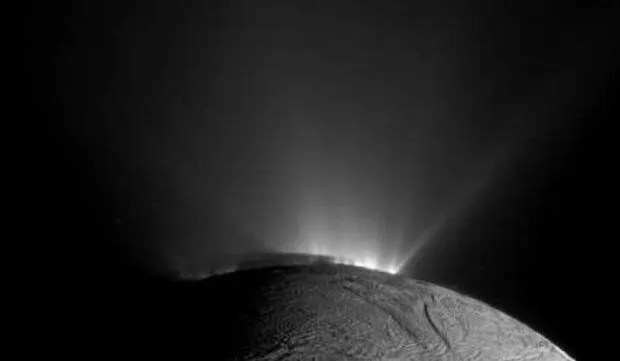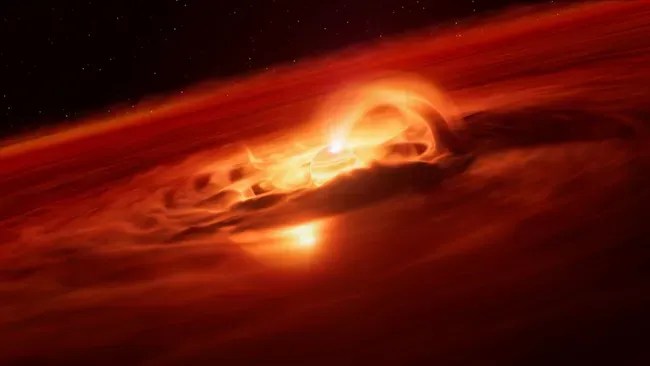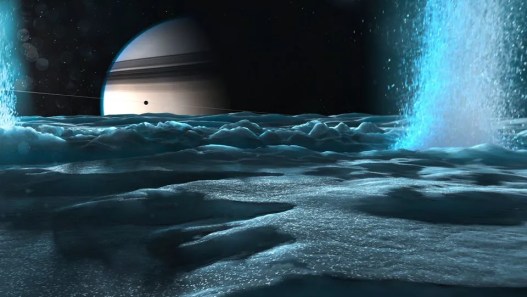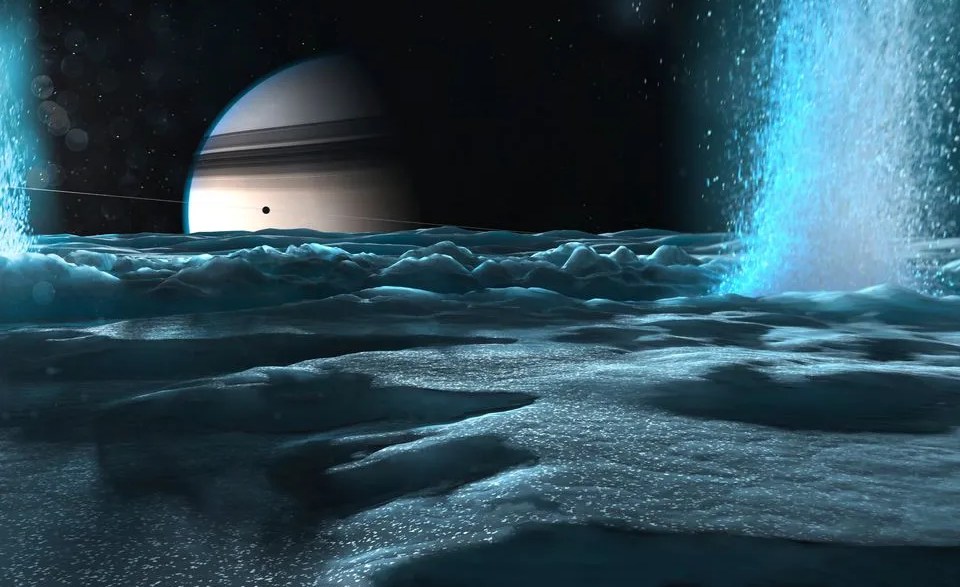The universe just got a lot more interesting. Within the span of a few days, astronomers have unveiled two discoveries that are rewriting the rules about where and how worlds form, grow, and potentially harbor life. One involves a tiny moon of Saturn that’s basically screaming “life could be here,” while the other features a rogue planet behaving more like a star and eating its surroundings at a mind-boggling pace. Both findings arrived this October, and both challenge what scientists thought they knew about planetary systems and the possibility of life beyond Earth.
Saturn’s Tiny Moon Is Packed With Life’s Building Blocks
Hidden beneath a thick shell of ice, Saturn’s moon Enceladus has been holding secrets. And thanks to data from NASA’s Cassini spacecraft, which flew through the ringed planet’s system between 2004 and 2017, those secrets are finally coming to light. The latest revelation? Complex organic molecules are abundant in the subsurface ocean of this 310-mile-wide world, fresh evidence published in Nature Astronomy that dramatically boosts the moon’s status as one of the best candidates for finding extraterrestrial life in our solar system.

For years, Enceladus seemed like an unlikely place to look for life. It’s tiny, cold, and orbits more than 800 million miles from the sun. But when Cassini flew past this white, scar-covered moon multiple times, it discovered something extraordinary: a vast ocean of saltwater lurking beneath miles of ice. Even more striking, the spacecraft detected powerful jets of water bursting through cracks near the moon’s south pole, launching tiny ice particles smaller than grains of sand into space at tremendous speeds.
Some of those ice grains fell back to Enceladus, but others drifted into Saturn’s outermost ring, known as the E ring. When Cassini flew through that ring, it was essentially sampling material from Enceladus’s hidden ocean without ever having to drill through the ice.
Fresh Samples Tell a New Story
Previous studies had identified organic molecules in those ice particles, including precursors to amino acids, which are the fundamental building blocks of proteins and life as we know it. But there was a problem: those particles had been floating in space for potentially hundreds of years, exposed to harsh cosmic radiation that could have altered their chemistry. Scientists needed fresher samples to confirm what was really happening in Enceladus’s ocean.

That’s where the new study comes in. Led by planetary scientist Nozair Khawaja from the Free University of Berlin, researchers took a detailed look at data collected in 2008 when Cassini flew directly into the spray erupting from Enceladus’s surface. Ice grains slammed into the spacecraft’s Cosmic Dust Analyzer at around 11 miles per second, and while the collision happened in an instant, the data it produced has taken years to fully analyze.
The payoff was worth the wait. Not only did the team confirm that many of the organic molecules previously detected were indeed coming from the moon’s subsurface ocean, but they also discovered entirely new classes of organic compounds that had never been documented on Enceladus before. These molecules exhibit a diverse range of structures and chemical characteristics, primarily consisting of carbon and other elements essential for life.
“Having a variety of organic compounds on an extraterrestrial water world is simply phenomenal,” said University of Washington researcher Fabian Klenner, who participated in the study. “There are many possible pathways from the organic molecules we found in the Cassini data to potentially biologically relevant compounds, which enhances the likelihood that the moon is habitable.”
More Than Just Ingredients
What makes this discovery particularly exciting isn’t just the presence of organic molecules, but what they suggest about the environment producing them. The types of compounds detected are similar to those found near hydrothermal vents in Earth’s deep oceans, where volcanic activity heats water and creates chemical reactions that support thriving ecosystems. Scientists believe Enceladus has similar hydrothermal vents on its ocean floor, potentially creating the same kind of energy-rich environment where life could emerge and flourish.
The moon already had several crucial ingredients checked off the list: saltwater, methane, carbon dioxide, phosphorus, and now a rich inventory of complex organic molecules. Study co-author Frank Postberg emphasized that the research proves “the complex organic molecules Cassini detected in Saturn’s E ring are not just a product of long exposure to space, but are readily available in Enceladus’s ocean.”
French astrochemist Caroline Freissinet, who wasn’t involved in the study, noted that while there wasn’t “much doubt” these molecules existed in the ocean, this confirmation provides “another piece in the puzzle.” She also highlighted how recent technology, including artificial intelligence, is allowing scientists to perform entirely new types of analysis on data collected nearly two decades ago.
The Big Question Remains Unanswered
Despite the mounting evidence, there’s a critical distinction scientists are careful to make: being habitable and actually being inhabited are two very different things. Khawaja himself acknowledged this, stating, “We believe that Enceladus is habitable, but we do not know if life is indeed present.”
In some ways, not finding life on Enceladus would be just as scientifically valuable as discovering it. “Even not finding life on Enceladus would be a huge discovery, because it raises serious questions about why life is not present in such an environment when the right conditions are there,” Khawaja explained.
To truly answer whether life exists on this small moon, scientists agree that a new mission is necessary. The European Space Agency has been studying the potential for a dedicated Enceladus mission that would land near the icy geysers and collect samples directly, or even attempt to penetrate the ice and sample the liquid ocean below. Meanwhile, NASA has spacecraft heading toward other potentially habitable moons: Europa Clipper is en route to Jupiter’s moon Europa and will begin dozens of flybys in 2030, while ESA’s Juice mission is also heading to Jupiter to explore Europa and two other icy moons with suspected buried oceans.
A Rogue Planet Breaking All the Rules
While Enceladus captures attention for what it might harbor, another cosmic oddball is turning heads for how it’s behaving. About 620 light-years away in the Chamaeleon constellation, a rogue planet designated Cha 1107-7626 is rewriting the playbook on planetary formation and growth.
Rogue planets are cosmic wanderers, worlds that drift through the galaxy untethered to any star. Most are thought to be cold, silent objects, ejected from their birth systems and doomed to float through the darkness of interstellar space forever. But Cha 1107-7626 is anything but typical. This planet is feeding.

Using the European Southern Observatory’s Very Large Telescope and data from NASA’s James Webb Space Telescope, astronomers caught this rogue world pulling in gas and dust from a surrounding disk at a rate that defies belief: six billion tons every single second. To put that in perspective, imagine the mass of Mount Everest being consumed roughly every second and a half.
“This is the strongest accretion episode ever recorded for a planetary-mass object,” said astronomer Víctor Almendros-Abad of the National Institute for Astrophysics in Italy, who led the study. “People may think of planets as quiet and stable worlds, but with this discovery we see that planetary-mass objects freely floating in space can be exciting places.”
Growing Like a Star, Not a Planet
What makes Cha 1107-7626 truly remarkable isn’t just the speed of its growth, but how it’s growing. With a mass between five and ten times that of Jupiter, this rogue planet is exhibiting behavior previously only observed in young stars and brown dwarfs. Yet it falls well below the mass threshold for either category: stars require at least 80 Jupiter masses, while brown dwarfs need at least 13.
When astronomers observed the planet in August 2025, they discovered it was in the middle of a massive growth spurt, accreting matter at six to eight times its typical rate. By comparing the light emitted before and during this binge-eating session, they found that magnetic activity was driving matter from the disk onto the planet’s surface, a phenomenon that has never been observed in a planet before, only in stars.
Even more bizarre, the chemistry of the disk surrounding Cha 1107-7626 changed during the burst. Water vapor appeared during the accretion episode but wasn’t detected beforehand, another trait associated with star formation, not planetary growth.
“This discovery blurs the line between stars and planets and gives us a sneak peek into the earliest formation periods of rogue planets,” said astronomer Belinda Damian from the University of St. Andrews.
A Mystery With No Clear Answer
The existence of rogue planets raises fundamental questions about how worlds form. Are they failed stars that never gathered enough mass to ignite fusion in their cores? Or are they fully formed planets that were violently ejected from their home systems through gravitational interactions with larger planets? Cha 1107-7626’s star-like behavior suggests the former might be true, at least for some rogue worlds.
“The origin of rogue planets remains an open question: are they the lowest-mass objects formed like stars, or giant planets ejected from their birth systems?” wondered study co-author Aleks Scholz, an astronomer at the University of St. Andrews.
The discovery implies that at least some planetary-mass objects follow a formation pathway more similar to stars than to the planets in our solar system, which formed gradually in a disk of material orbiting the sun. If that’s the case, these objects might be more common than previously thought, hidden in the darkness between stars and nearly impossible to detect unless they’re caught in the act of feeding, as Cha 1107-7626 was.
At roughly one to two million years old, this rogue planet is still in its infancy by cosmic standards. The accretion burst observed by astronomers persisted for at least two months, and there’s no telling when or if it will stop. Future observations with increasingly powerful telescopes, including the upcoming Extremely Large Telescope with its record-breaking mirror, should reveal whether such feeding frenzies are common among rogue worlds or if Cha 1107-7626 is genuinely unique.
What It All Means
These two discoveries, announced within days of each other in early October 2025, represent different frontiers in humanity’s exploration of the cosmos. Enceladus offers the tantalizing possibility of life within our own solar system, potentially thriving in a lightless ocean beneath an ice shell, far from the sun’s warmth. It’s a reminder that habitability doesn’t require Earth-like conditions; it simply requires the right chemistry, energy sources, and liquid water.
Meanwhile, Cha 1107-7626 challenges our understanding of how planets form and evolve, suggesting that the boundary between planet and star isn’t as clear-cut as textbooks suggest. It also hints at the possibility that our galaxy might be teeming with rogue worlds, outnumbering the planets that orbit stars, drifting through the void with their own disks and possibly even their own moons.
“The idea that a planetary object can behave like a star is awe-inspiring and invites us to wonder what worlds beyond our own could be like during their nascent stages,” said ESO astronomer Amelia Bayo.
As Ray Jayawardhana of Johns Hopkins University noted, the rogue planet discovery implies “that some objects comparable to giant planets form the way stars do, from contracting clouds of gas and dust accompanied by discs of their own, and they go through growth episodes just like newborn stars.”
Underground oceans on moons and rogue planets gorging on matter in the darkness of space might seem like science fiction, but they’re very real phenomena happening right now in our cosmic neighborhood. As physicist Nigel Mason from the University of Kent stated, underground oceans on moons “are perhaps the best candidates for the emergence of extraterrestrial life in our solar system. This work only confirms the need for further studies.”
Between Enceladus’s ocean world and Cha 1107-7626’s record-breaking growth, one thing is clear: the universe is far stranger, more dynamic, and potentially more hospitable to life than anyone imagined just a generation ago. The only question now is what we’ll discover next.














